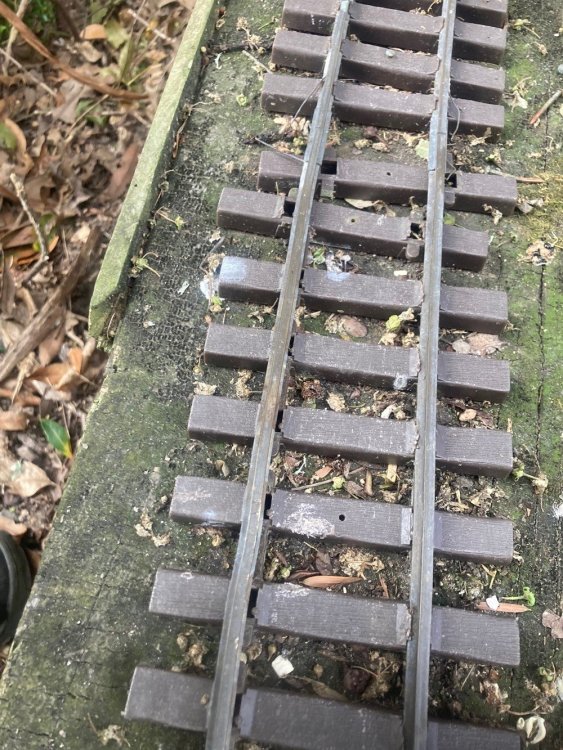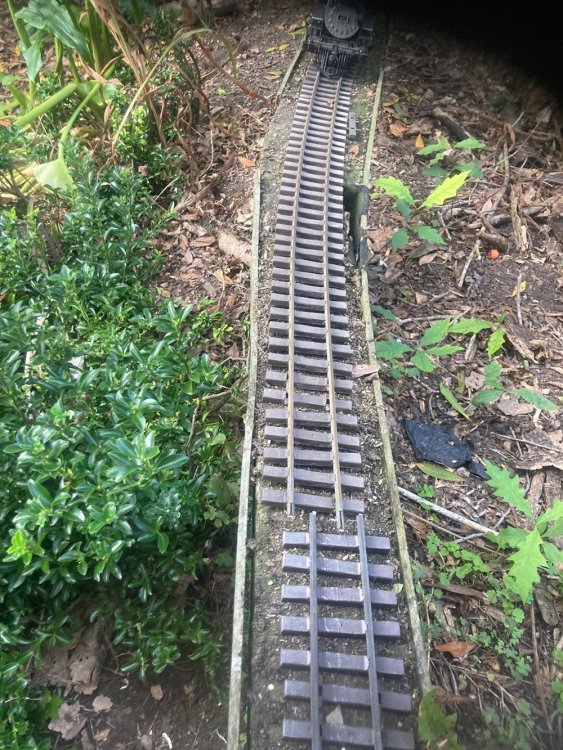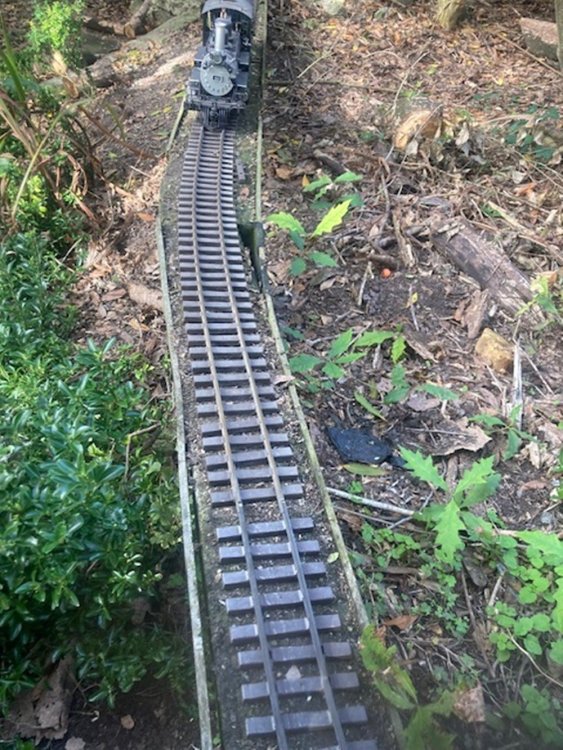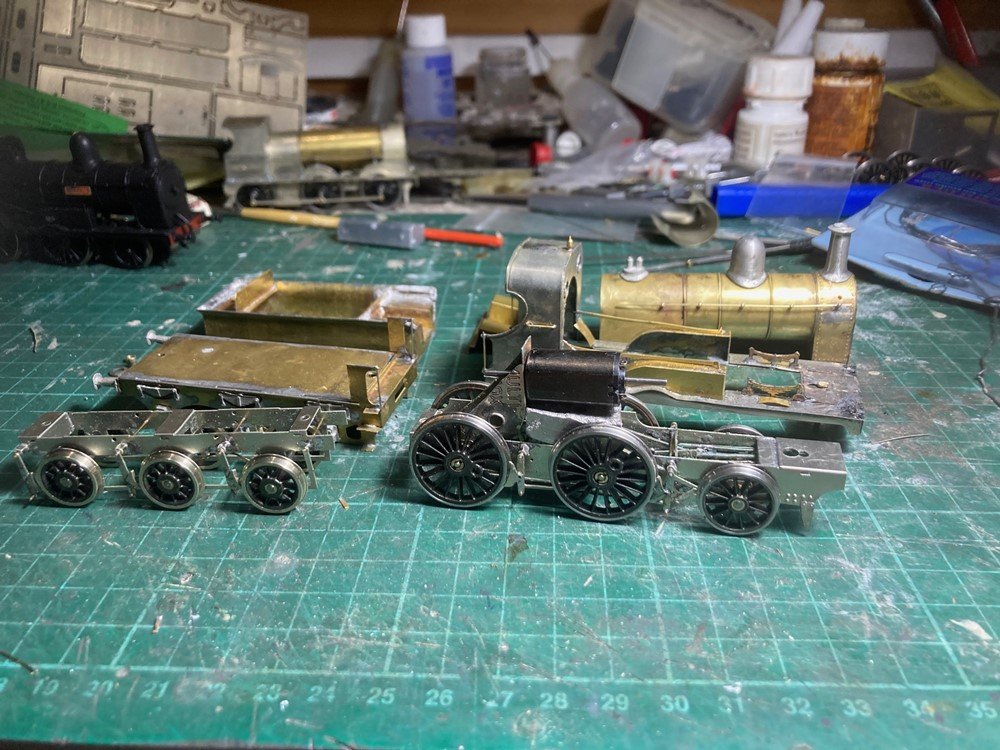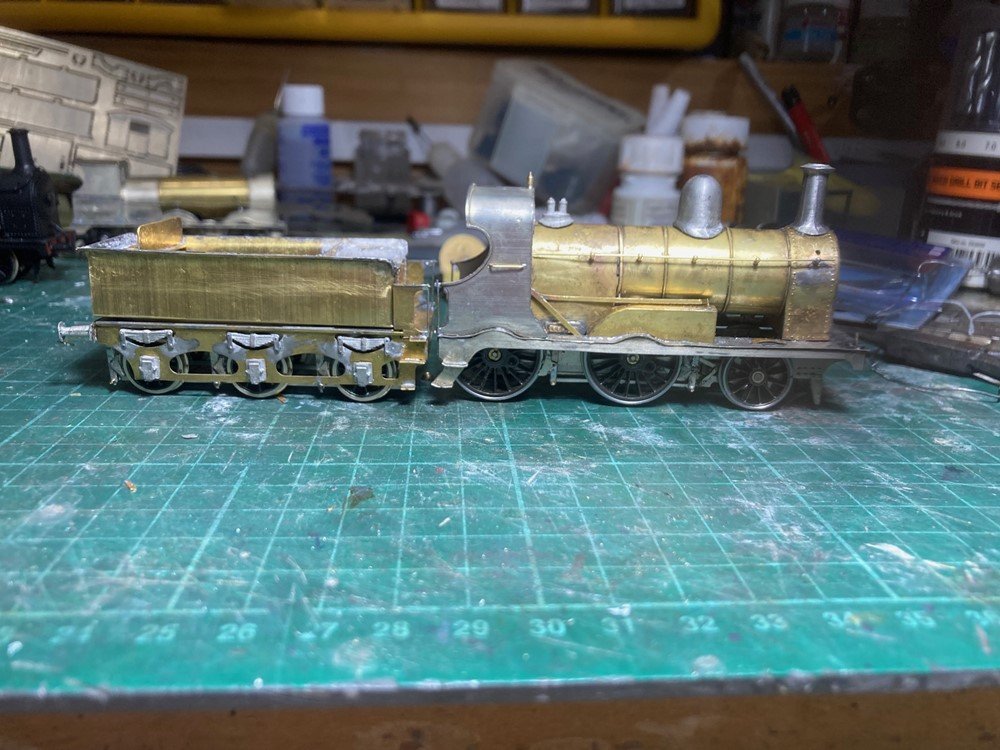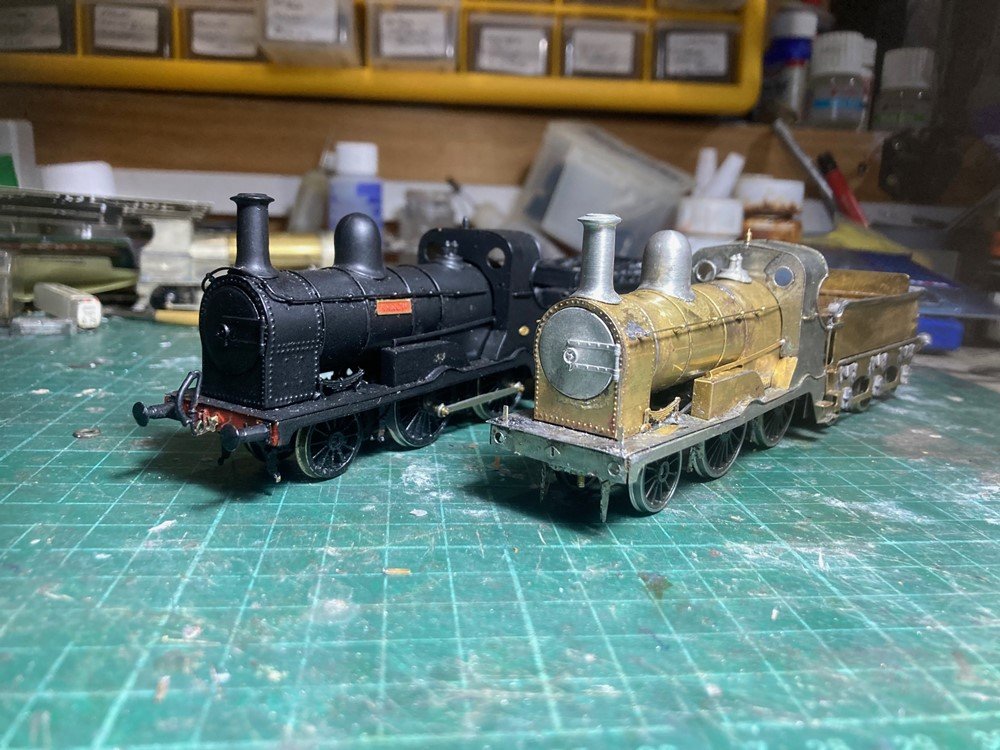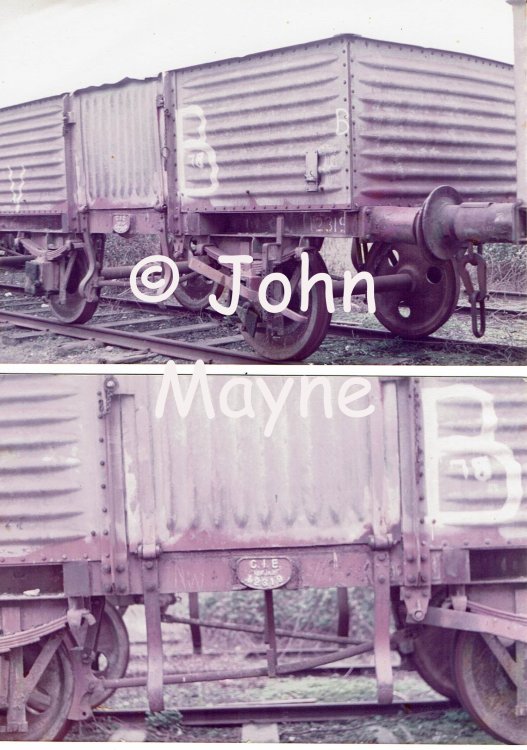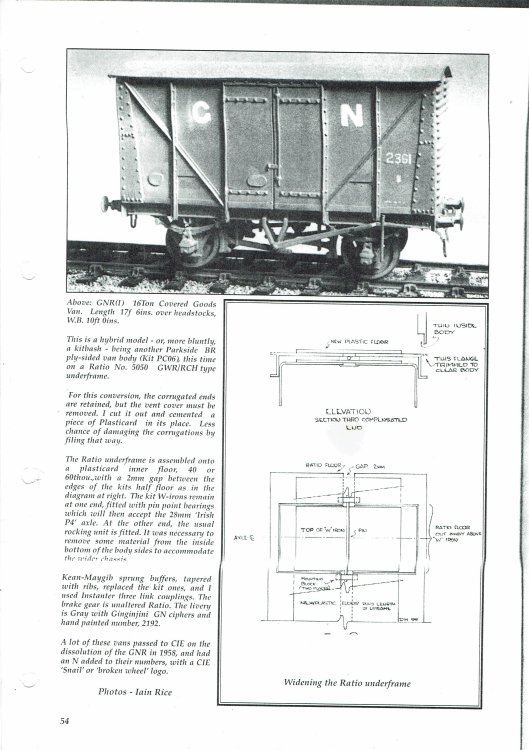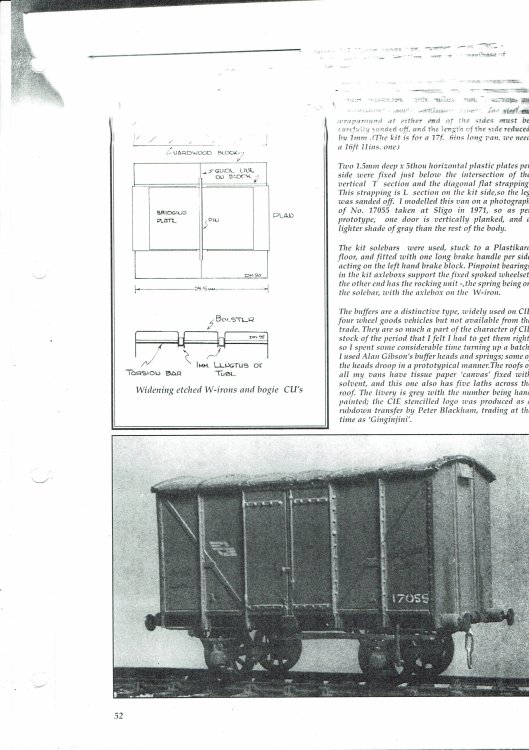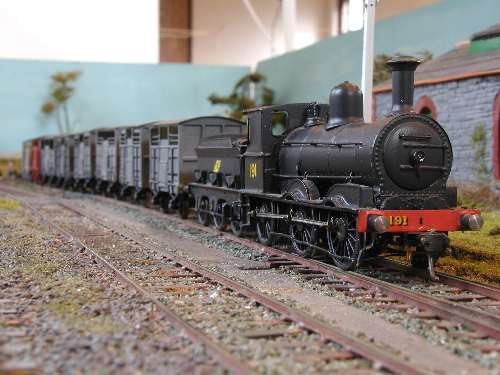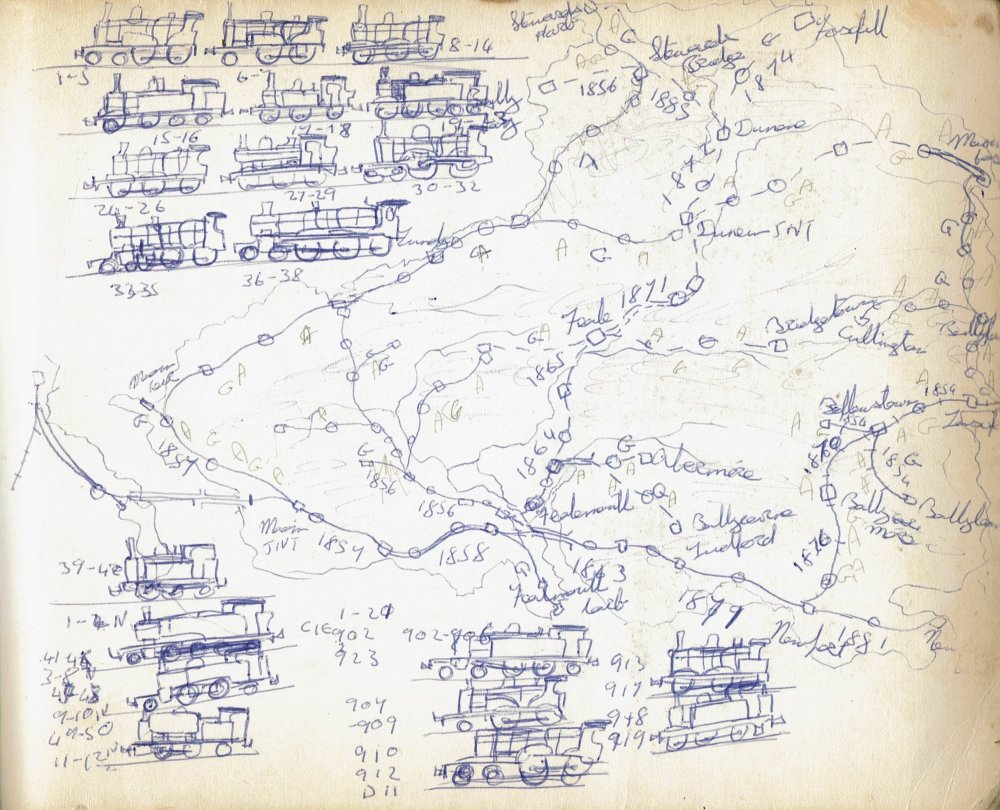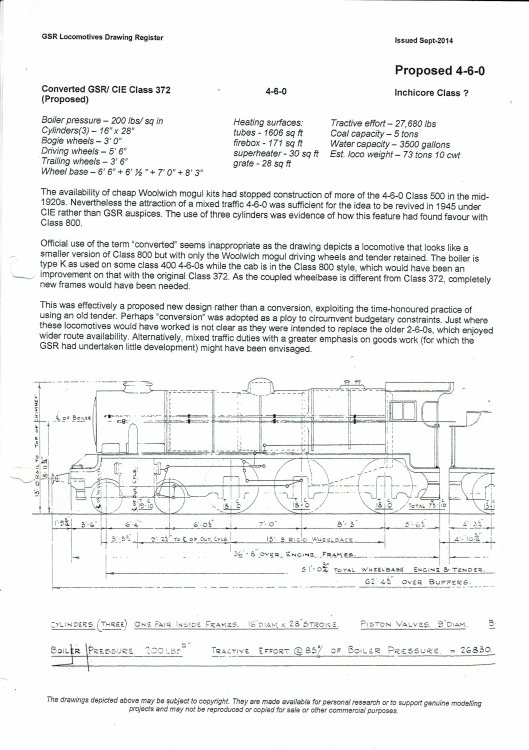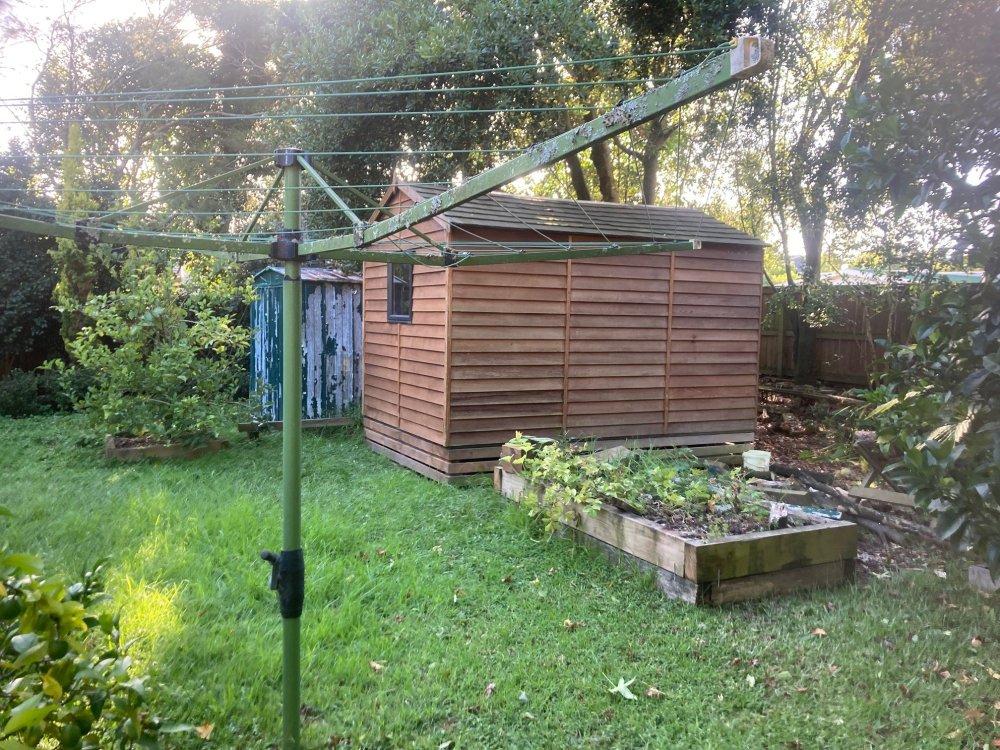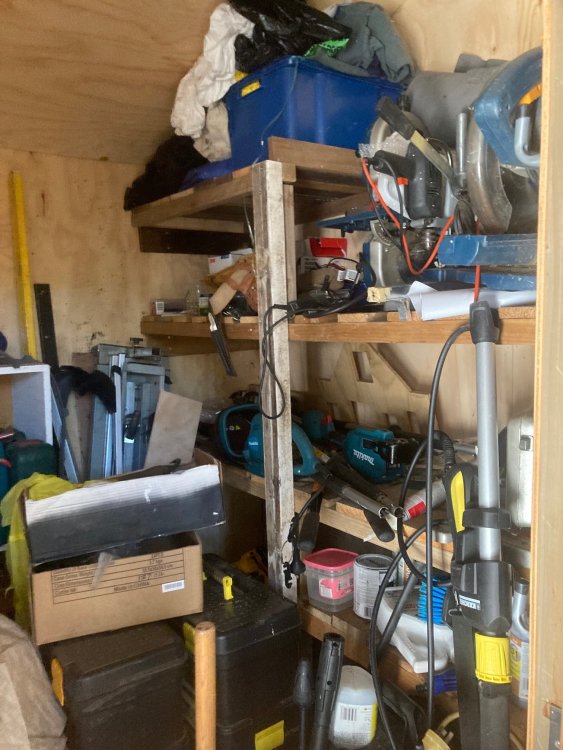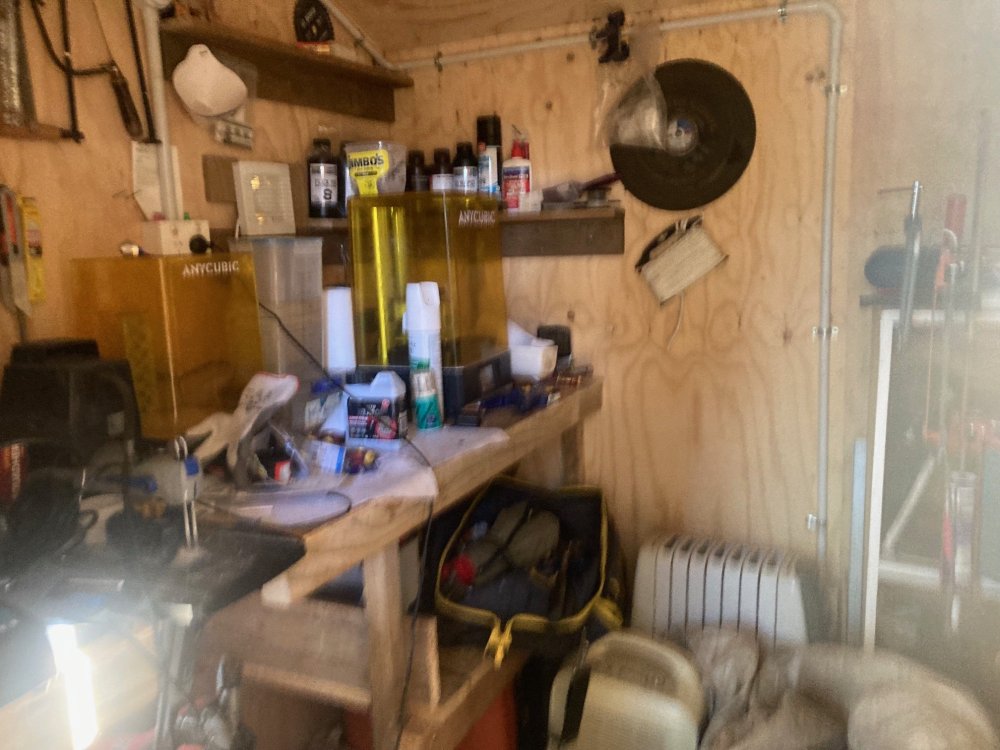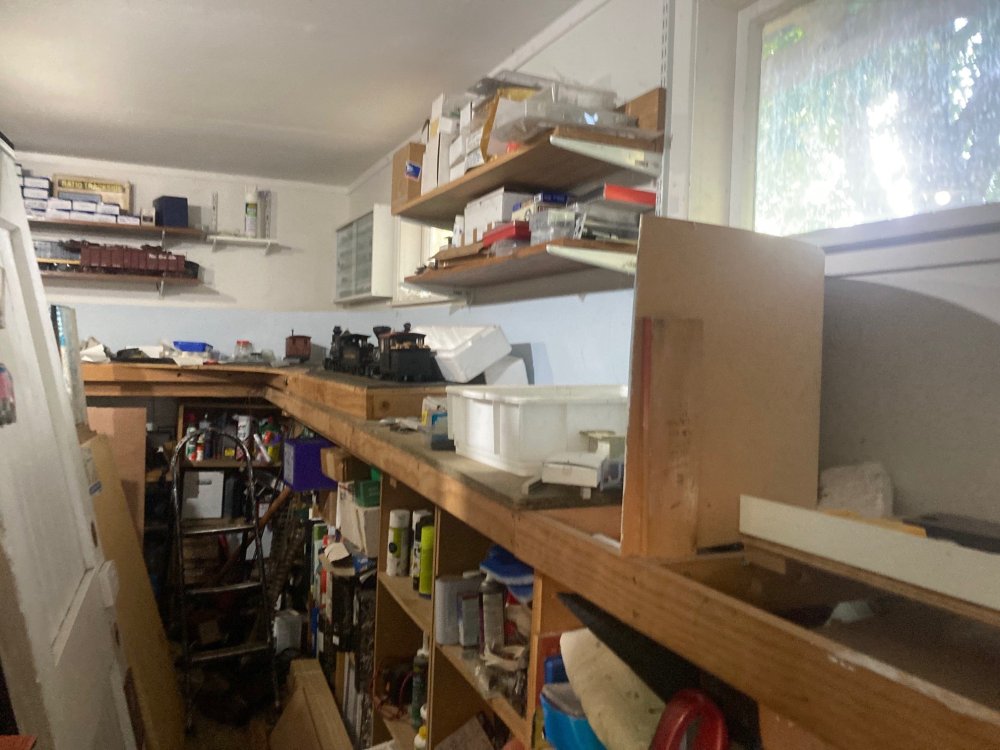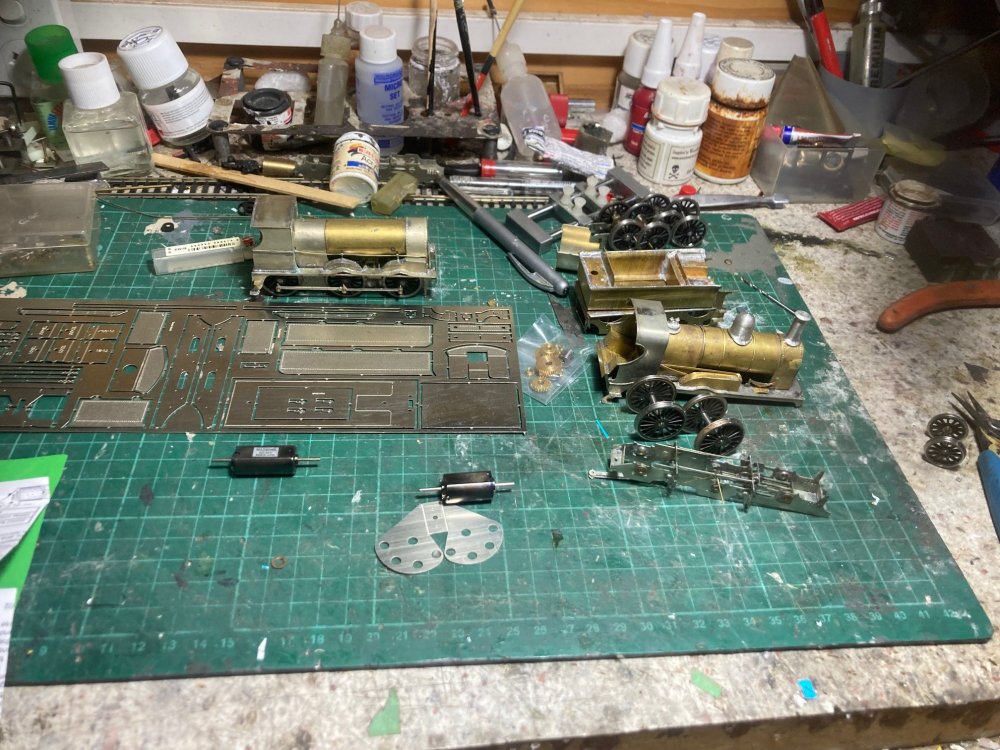-
Posts
4,884 -
Joined
-
Last visited
-
Days Won
119
Content Type
Profiles
Forums
Events
Gallery
Blogs
Community Map
Everything posted by Mayner
-

To regauge or not to regauge that is the question
Mayner replied to TippTrainLad's topic in General Chat
David put it succinctly 21mm gauge can be laid to OO/EM profile wheels and running clearances, but not really suitable for sharp/small radius curves (I use 2'6" as a minimum on plain track) and points need to be at least 3' radius. Its important to understand that EM/OO fine wheels are to a finer/narrower profile to wheels fitted to RTR locos and stock and importantly that critical dimensions such as wheel Back to Back and Flangeway Clearance vary between EM and Double O Association Intermediate Track and Wheel Standards. I use EM profile wheels set with a Back to Back of 19.3mm for the majority of my locos and stock with a Flangeway Clearance of 1mm while Brendan 8056 uses existing (NMRA) profile wheels with the B-B set at 19mm presumably with a wider flangeway clearance. It was necessary for me to reduce the thickness of the bogie sideframes of a B141 re-gauged with the original Bachmann wheels as the wheels rubbed on the sideframes with the B-B set to 19.3mm. Clearance between wheels and side frames was not a problem on my B141s fitted with narrower EM profile wheels. While diesels and stock are relatively simple to re-gauge, a 21mm gauge steam outline loco is basically a scratch or kit building exercise in sheet metal due to the very tight clearances between wheels, splashers, outside cylinders/valve gear on the full size locomotive. I think Stephen or Fran from IRM/Accurascale pointed out that it was not practicable to produce an EM gauge variant of the Accurascale GWR Manor due problems achieving sufficient clearance given the characteristics of the material used, on of the reasons British OO exists. -
The existing Parkside kit https://www.petersspares.com/p/parkside-models-pc65-br-12t-palvan-kit-oo-gauge is probably a better and cheaper option than the new Bachmann model for modelling the CIE Palvan. Apart from the underframe the main visual difference between the CIE and BR vans was that the Irish Vans were fitted with sliding doors (2 types) and three different types of end stampings. Some of the vans were fitted with corrugated ends similar to the standard BR Van, its possible to produce this type of van by doing a 'mix n match" between a Parkside Pallet and Ply sided van kits as outlined in James Hiltons recent article on Irish vans https://paxton-road.blogspot.com/2024/03/irish-vans.html The underframes on the CIE Palvans were quite unlike the BR vans a combo of Bulleid Triangulated Underframe, axleguards with spring dampers like the BR Pallet Vans and 'either side" brake gear similar to that fitted to older style British built tank wagons a very strange combo. The Bachmann/Parkside chassis are best described as near enough for the Irish pallet vans if you don,t look too closely.
-
A lot of the crap on Facebook/social media is relayed by the older generation, have a relative in their 80s form the States that only posts Trump/Republican Party propaganda and conspiracy theory stuff, while our 14 year old simply chats with their friends and shares selfies and artworks on social media. Populist politicians tend to appeal to the age group or people that feel "that they have been left out" by main stream politics leading to Brixit in the UK and quite reactionary governments in this part of the World. This in turn leads to increasing discontent among an upcoming generation who feel that they have been let down by their parents and grandparents generations, interesting ties in the next 15-20 years! We use facebook to chat between family in gthe States and New Zealand but ignore most of the postings.
-
Its possibly Fintown Railway staff are paid by Údarás na Gaeltachta under a social employment scheme but there may be no public funding available to actually maintain or operate the railway. Several preservation schemes in the South were able to employ staff under a social employment scheme (work for the dole), with the preservation group responsible for paying for materials and consumables. Shortage of workers or volunteers was not really a problem, but the lack of/inadequate funding for heavy maintenance/overhaul work
-
Looking back at my family history to the 1880s the two things that stand out is that each generation went through a phase of youthful rebellion, (made their own decisions sometimes in the face of opposition from those in authority (sometimes parents and religious) ) and each generation worked through life's up and downs to bring up the succeeding generation. One interesting pattern on both sides of our family is women from old Irish families marrying men of English and Scottish ancestry (widen the gene pool?), though I changed the trend and married a woman of Viking/Germanic ancestry who is equally strong minded. As a kid I remember a priest working himself into a lather during a sermon the World was about to end. He could not tell the difference between the sexes with boys and girls wearing long hair and similar clothing. Parental opposition to a cousin going-out with a girl they considered low class, the couple eloped and have stayed together for over 50 years and are now great grandparents, but are at heart still a 60s couple. Another cousin considered a failure in a family of high achievers became a left wing political activist and surprised his surviving brother and sister with the turnout of political dignitaries (all sides of the political spectrum) at his funeral. We cannot judge succeeding generations by our own standards or without looking in the mirror.
-

To regauge or not to regauge that is the question
Mayner replied to TippTrainLad's topic in General Chat
B141 conversions using original Bachmann wheels top photo, Ultrascale EM profile wheels lower photo. It was necessary to thin down /reduce the thickness of the Bogie sideframes using the Bachmann wheels with the wheel Back to Back measurement set at 19.3mm based on EM running clearance, there is sufficient clearance and no need to reduce the thickness of the sideframe when using EM profile wheels available from Ultrascale or Gibson. Ultra scale supply 21mm gauge wheel sets to order in both P4 & EM profiles, better wheel than Gibson but longer lead time to delivery. I used 26mm plain axles available from a local supplier for the Bachmann Conversion Setting up Ultrascale wheelset with Bachmann axle brushes and gear, the top hat brushes between axle brush and wheel are basically spacing washers to minimise side play. The steel object is a Back to Back gauge bought from TMD the predecessor of Studio Scale Models ,many moons ago. The Crude Hornby but it works old type Stanier bogie converted to 21mm gauge Piece of .60 Thou plasticard used as replacement bolster. 2mm bore brass tube used to sleeve standard axles cut in half, wheels are PC Models a long discontinued brand bought at a clearance sale about 30 years ag. Same principal but more sophisticated. MJT "Suspension Units" packed out to accept 21mm gauge wheel sets used under a Laminate coach assembled using a Worsley Works set of parts. Wheels appear to be Gibson EM profile wheels on locally sourced 28mm pin point axles. Purpose design of 21 or 16.5mm gauge Studio Scale Models GSR Bredin Coach. Dapol ESSO Tank wagon. Solebars packed out to accept 21mm wheelsets. Similar principal used to convert Parkside BR Van and Pallet Wagon to 21mm gauge Irish models -

To regauge or not to regauge that is the question
Mayner replied to TippTrainLad's topic in General Chat
The question of re-gauging really depends on whether you prefer to spend your time model-making/modifying models or prefer to spend your time running ready to run models. A lot depends on the track and wheel standard adapted P4 will require replacement of existing wheels with P4 profile wheels and potentially greater care in baseboard construction and tracklaying than the coarser standards, EM profile wheels should be used if you adapt EM running clearances, existing NMRA RP25 profile wheels fitted to the majority of rtr models are suitable for use with OO (Double O Gauge Association) running clearances. https://doubleogauge.com/standards/ The original version of the MM 141/181 was easy enough to re-gauge to 21mm gauge by replacing the existing axles and re-using the existing gears and wheels if you adapt OO running clearances, or with some thinning down of the bogie sideframes if you retain the existing wheels and adapt EM running clearances Hand laying track and points takes longer than using Peco but can result in a more realistic appearance both in terms of track gauge and overall appearance of the track. The IRM Bogie wagons can be re-gauged by moving out the wheels on the axles, the IRM MK2 Bogie coaches are designed for the wider 21mm gauge, but the axles/wheel sets may require replacement. Earlier IRM and MM and Provincial Wagons stock require modification to the chassis/bogies to run on 21mm gauge. I have worked in 21mm gauge for over 30 years, but haven't gotten round to building a layout as I get most of my enjoyment out of building locos, stock and buildings and haven't really had time to build a layout. Most of my locos and stock are CIE/GSR steam era were built from kits and modifying ready to run not really an option in the first place. If you are seriously considering re-gauging the first step would be selecting a wheel/track standard which largely determine the level of care/precision required in baseboard building and tracklaying, but also determine the minimum radius of curve feasible the more accurate the wheel/track running standard the greater the minimum radius required, I have successfully used a minimum radius of 30" using EM wheel profile/running clearances, adapting Double O Association standards may allow a small minimum radius. Another approach is to mount the layout at or close to eye level and use a finer track like Peco Code 75 or Bull Head both of which are closer to scale in appearance than the standard Peco Code 100 track, the eye level view point distracts the eye from the appearance of the narrower gauge. Possibly what I would do if I was starting out with a blank canvas in 2024. -
The LGB Tram and 4w coaches are good sturdy models capable of running forever and not unlike early Schull and Skibereen stock. Deltang https://www.deltang.co.uk/ are a good UK source of battery radio control equipment. Unlike DCC large scale battery radio control the majority of suppliers are 'cottage industry" businesses some of whom use Deltang components, the RCS (Australian) radio control system on my garden railway is based on Deltang components. Traditionally people placed the battery in a coach or wagon behind the Tram or Stainz loco, though I used a custom made battery of AA NiMh cells to power my LGB DRGW 0-4-0 diesel loco.
-
S Scale on 16.5mm track popular in New Zealand for modelling the 3'6" narrow gauge. scale also popular in the States for both standard and narrow gauge modelling, https://www.brians-place.com/models/S-Scale/railwaymodels.html Apart from being primarily a scratchbuilders scale S is a nice intermediate scale between OO and O. Easier to work in than OO/4mm as eyesight and manual dexterity deteriorates as we get older and takes up less space than a similar model/layout in O Scale.
-
Came across the first 'work' mobile while working in construction about 40 years ago the owners of the company had 'car phones" powered by massive batteries in the boot. Two way radio was used for communication on larger sites, earth-moving and transport businesses. Everything was open channel with great banter between drivers, plant operators and the boss. Without secure channels we overheard communication from a "Security" company that transported cash and valuables in the Watford area, being amateurs it took us some time to identify the company, who were very defensive about their security breach. Was supplied with a work cell phone from the early 90s, had to account for private calls on a monthly basis, and realised that they were useful if the work car broke down in on private travel. In more recent years employers became less strict about private phone use and no longer required to account for calls. Bought my first mobile a Samsung when I 'retired" about 5 years ago, but had to replace it with an iPhone to control a drone used in connection with a new business venture. Managed to mislay my iPhone, bank cards and cash in a car park at a shopping centre a couple of weeks ago, didn't realise that it was gone for about an hour. Luckily a Courier driver spotted the phone and holder and handed it in at the shopping centre Information Desk a very lucky escape.
-
A bit of background three train collision calls for Norfolk Southern CEO to be removed. https://www.mcall.com/2024/03/03/cleanup-investigations-continue-for-norfolk-southern-train-derailment-in-lower-saucon-township/
-

Clogherhead - A GNR(I) Seaside Terminus
Mayner replied to Patrick Davey's topic in Irish Model Layouts
Pontoon Ballroom was the place to go in the West 'himself" cloven hoofs and all was a regular, but a reputation of always being a perfect gentleman towards the ladies. The local lads had no chance -
Something of a break through made time this week for some overdue maintenance on the garden railway and carry out some detailing on No 664 A section of track on the Garden Railway was damaged by a by a falling tree in a storm last year and locos continued to de-rail on this section of track despite attempted repairs. One of the rails on this section was buckled narrowing the gauge and needed replacement. Left rail buckled, moulded rail fastening have failed combination of storm damage and plastic ties (sleepers) and fastening becoming brittle after 16 years exposure to the weather. I replaced the section of track with the buckled rail with a spare section from the workshop though the ties/sleepers are not in great shape. 464 navigated the repaired section without de-railing so the railway should get through this years 'Fall Stock Rush" I have bitten the bullet and ordered €300 worth of replacement tie strip to replace approx 60' of failed ties/sleepers on the main circuit, I replaced the ties on the remainder of the main line about 10 years ago, the new ties should be good for another 15-20 years similar to full size wooden sleepers. The next big way and works job is to replace a series of fence posts (that have rotted) that support the trackbase on the High Line from the Workshop to the main circuit, like a full size railway there is no end to the maintenance and replacement work as components reach the end of their working life. 664 main sub assemblies. Loco was dismantled following trial fitting of gearbox and motor. I had just cut a slot out of the lower section of the boiler to allow the motor to fit. The loco is weighted with Woods Metal cast in the loco and tender body. The weight under the motor needs to be tidied up, Woods Metal appears to expand during casting. Most of the detailing has been applied to the loco, although I need to fit front buffers, vac pipes and ejector pipework. More substantial work is required on the tender chassis including fitting an NEM coupler pocket similar to that used on the 52 Class 4-4-0 sorting out locotender drawbar and power pick up wiring. I will dismantle the loco into a set of sub assemblies and complete the mechanical assembly after I have completed painting (GSR Grey) and varnishing the model. Although 657 (33 Arrow) and 664 (23 Sylph) were both re-built in the mid 1920s with superheated boiler and canopy cab 664 was rebuilt with a saturated boiler (original MGWR Type) in 1930 and went through two further boiler changes and an Inchacore 'style" cab before withdrawl in 1961.
- 392 replies
-
- 15
-

-
These days freight terminals are usually set up in newly established industrial areas on the outskirts cities, close to major road/motorway junctions. Locally the recently established Ruakura Inland Port set up as a joint venture between a Port Company and a property company has sidings set up to handle 40 wagon container trains. https://www.ruakura.co.nz/explore-the-superhub/ruakura-inland-port/
-
Steelwork spray painted red-oxide to prevent rust, galvanised steel body left unpainted when when wagons overhauled for beet traffic mid-70s Wagon dumped out of service at Liffey Junction 83-4 had been used as spoil wagons on the DART project for several years.
-
In commercial construction an Estimator or a Senior Quantity Surveyor will prepare costings (and appoint contractors) for a project in consultation with members of the senior management team who are usually of an Engineering or Construction Management background rather that working is separate silos. Part of the problem may have been a reluctance by managers from an Engineering or Construction background to question the assumption of an Estimator or Quantity Surveyor (member of a separate professional body) As a Site Manager or Foreman I only got involved after a successful bid, my role was identifying issues and risks at an early stage including questioning design, estimating and final assumptions. At organisational level there tended to be two responses either to work through the issues or pretend they did not exist. I tended to jump ship quickly with the latter kind of organisation, staying around was not worth the hassle.
-
Interesting there is an old saying that there is nothing new in the World, James Hilton's blog is largely a repeat of work published in UK magazines during the 80s and 90s by David Malone a UK based Irish P4 modeller who used the Parkside BR Van as a basis for the CIE H Van and GNR Bagged Cement Wagon. David's wagons were assembled to P4 standards which involved significant modifications to chassis and running gear. David mixed & matched the Parkside BR van body with a Ratio GWR underframe to model the distinctive GNR 16T Bagged Cement Van The H Van (early versions) used Parkside sides and roof with scratchbuilt ends and Irish single lever brake gear. His ModelRail Digest article on Irish Goods Wagons included examples of scratchbuilt wagons including a Bulleid Open and a 20T Brake
- 4 replies
-
- 10
-

-

-

-
The Momod train had quite a following among the UK Garden Railway fraternity. Should be able to download the instructions http://www.eagleassist.com/hglw/Mamod Handbook.pdf Mamod Handbook[22677].pdf
-
Not just Britain but prevalent 'as value engineering" (skimping) at an international level in construction. Senior management began to panic that I was using substantially more stone fill than they had estimated on the Masonite Ireland project in County Leitrim during the mid 1990s. In commercial construction the Contractor buys stone fill by from the supplier by the Tonne and is paid by the Main Contractor or Client by the Cubic Meter. When the panic set in our engineers were instructed to (physically) check and re-check the volume used and kept coming up with the same answer in Cu/M which did not tally with the tonnage used, until I pointed out that the density of the stone supplied from the Roadstone Boyle Quarry average 2.5T/m³ well above the theoretical 1.6T/m³ used in the estimation text books. We had a similar panic while working for the same firm on a Dublin project and decided it was time to move to a firm with a more practical pragmatic management culture. Moving to my first job in New Zealand I spent my first day laughing at the level of skimping on an Auckland Apartment project which made engineering design on Irish and UK projects of the 2000s era look extremely high cost and conservative (cautious) in comparison. I quickly made two decisions (1) not to buy a post 1970s home because of the high risk of defects (2) to get our of construction or work on my own account due to the hassle working for the larger companies in the industry, a decision that me basically took me through to retirement without too much hassle
-
The smiling guy looks remarkably like a developer and would be FF politician I once worked for No interest in trains that I know of, specialty was financing hotels and apartments through BES (legal money laundering), but lost a lot of his empire (fortune) through paying inflated prices for development land before the GFC, but managed to claw a lot back when the dust eventually settled.
-
Probably best ask Mary O'Rourke or her sons who should be well able to pull the strings prominent local family. https://en.wikipedia.org/wiki/Mary_O'Rourke As Minister of Transport Mary was vehemently opposed to the 1990s proposal for a National Railway Museum at Mullingar which had a business plan, IE, RPSI & ITG backing and campaigned for the museum to be located in Athlone, then all went very quiet after the Mullingar scheme got the axe. Main issue with Athlone is the large loco depot at the West end of the yard was demolished and cleared track lifted many years ago, Goods Shed and Old Loco depot different sides of the main running roads and small for modern use. Don't ask about the cost of installing and maintaining a connection from either the Old Loco depot or the Down Yard to the main running lines, the Great Southern Railway Preservation Societies and Westrail lost their mainline connections and ended up with stock stranded when Irish Rail disconnected the loco yards at Mallow and Tuam from the main line.
-
Whatever way you look at it Kerry County Council have saddled the ratepayers with a huge on going liability with the railway. The TDs and Councillors who made the decision to support the building of the railway have evaded responsibility for poor decision making and failure in the upkeep of the railway. A commercial operator would expect the Council to cover the cost of restoring and maintaining the railway and its stock, and provide a PSO style grant to meet the difference between fare income and operating costs (including a management fee). Obtaining adequate insurance to indemnify the Council against future liabilities arising from the railway would be a major hurdle to the council leasing or selling the railway to an enthusiast group. Irish Insurers are wary about insuring railway undertakings, CIE/IR self insures, the Waterford and Suir Valley used a UK insurer unable to obtain suitable insurance in Ireland, I The Council operating the railway with paid staff (possibly employment training scheme) with volunteer assistance would probably be the cheapest/most economic option, with 'tourist businesses" that benefit from the railway paying a 'targeted rate". Back in the day local ratepayers guaranteed a 5% return on Tralee and Dingle shares and were required to make good operating losses, eventually the Council took over management of the old railway when it failed to make a profit, but the ratepayers were required to pay the dividend until the Free State government bought out the shareholders of the "Guaranteed Lines". Nothing really has changed in Ireland over 130 odd years, Investors come up with schemes that can never pay their way, politicians make bad decisions and the ordinary tax payer pays. .
-

Would you model in 21mm if RTR track and models were readily available?
Mayner replied to BosKonay's topic in Irish Models
As far as I recall Brian Fennell had TMD/SSM CIE J15, GNR S Class 4-4-0 (Black) GNR GG 0-6-0 a 3 Coach rake of SSM GNR Coaches (2 K15 Open+ 1 Brake end) Rake (5 coaches) SSM GSWR 6 wheel coaches GSR Maroon 1 assembled as a MGWR coach, Scratchbuilt -rake 10-15-Irish Standard Covered Wagons (GNR/MGWR) rake GSWR Cattle Wagons. Brian also had a Bandon Tank scracthbuilt by Tim Cramer during the early 70s, Tim disposed of his 4mm collection through Southern Model Railways when he moved up to O Gauge. All operated ran well at exhibitions, locos had Ultrascale Wheels and Mashima Motors, Wagons were scratchbuilt in plasticard ran on Jackson (brass) wheels on 28mm pin point axle (probably machined by Brian), all stock were fitted with Kadee No 36 couplers. Kadees were very reliable in operation with delayed un-coupling though shunting 14' GSWR cattle wagons cou;d be trick due to the short length of the wagons, I used ran my 14' GNR cattle wagons in pairs with 3 link coupling at one end Kadee at the other avoiding the accidental uncoupling problem when making up a train. Another member had a 21mm gauge GN JT 2-4-2T a RTR model produced by the late Harry Connaughton a commercial model maker during the early 1970s TMD J15 191 arriving with a cattle train at MRSI Exhibition Clontarf 2002. With readily available TMD/SSM loco and carriage kits, none of us scratchbuilt the correct (ex) Midland locos or stock to run on the layout. -
In my early teens I dreamed up an Island railway system off the coast of Wicklow independently operated with GWR influence but linked to the CIE system (I had never heard of Thomas, Sodor at this stage!) Modern main line steam locos had a definite GW influence, though there was a later Bulleid influence with an "Airsmoothed" 2-6-2 influenced by the DB Class 23 of the 50s, before going down a locally manufactured version of the NBL diesel hydraulics before a CIE takeover in the 70s. The Island had a heavy industry base including steel manufacture and shipbuilding. Going back a tweeny weeny bit closer to reality during the 1940s CIE proposed "re-building" the Woolwich Moguls into 3 cylinder 4-6-0s combining a 400 Class Boiler, 800 Class chassis cylinders and motion and Woolwich driving wheels. The end result would have looked reasonably close to an LMS "Patriot" 4-6-0 with small wheels and likely to have been a useful go-almost anywhere loco combining proven, boiler, running gear and wheels, its possible a 6'7" version would have been built to bring the various 400 Class subclasses into line. Like the Bulleid Pacifics the 3 cylinder layout of the 'rebuilt' Woolwiches would have been easier on the track that 2 cylinder locos like the Woolwich or 400s, could have been used on the Midland, Mallow to Tralee and possibly Rosslare-Cork useful locos. The Patriot would be a close enough model in general outline, though the tender would probably been more modern in design, though Inchacore just might have kept the existing Woolwich tenders which were basically a Midland/early LMS design. Proposed 372 Class 4-6-0 1945
-
We more or less bought the place on gut instinct after a day visiting Open Home. Climate is a bit like the West of Ireland bit warmer without the snow, Spring tends to be dry, get lashed by gales (tail end of tropical Cyclones) during high Summer (Jan-Feb) Unfortunately little time to play trains as a result of family commitments these days, though I did manage to tidy up the workbench to complete some unfinished projects and finish a (dead) tree felling/chipping exercise that will leave me with mulch for the garden next Spring (Sep-Nov) Inside what was originally intended to be Wifes arts studio, I need to set up steel racking down the centre for more boxes of stuff from inside the house. Grass had grown about 4" since mowed 2 weeks ago, the Waikato is good cattle rearing country, not great for cropping. Small workshop the curse of finding storage space for electric/battery garden power tools Not a good idea for using the workshop for 3D Resin Printing challenging to maintain temperature and humidity at adequate levels for successful 3D printing +25ºC 45%RH despite room heater and de-humidifier. Flame proof electrical and ventilation (Intrinsically Safe) system required using and post print cleaning of solvent based resins. (Large volumes of IPO used as a clean up agent.) Railway room/workshop, baseboards and backscene for 'permanent' layout set up 10 years ago, used mainly for storage! Cleared the workbench for the 1st time since May 2023. Need to finish the ex-MGWR 2-4-0 for a customer and a J15 for myself, which should help keep me occupied for a few months.
.png.c363cdf5c3fb7955cd92a55eb6dbbae0.png)



